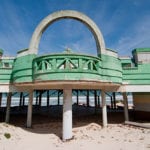 Mysteries
Mysteries  Mysteries
Mysteries  History
History 10 Surprising Stories About the Texas Rangers
 Humans
Humans 10 Philosophers Who Were Driven Mad by Their Own Theories
 Miscellaneous
Miscellaneous 10 Video-Game-Worthy Weapons and Armors from History
 Weird Stuff
Weird Stuff 10 Psychics Who Accurately Predicted Wartime Events
 The Arts
The Arts 10 Pieces of Art Inspired by a Broken Heart
 Health
Health 10 Science Fiction-Sounding New Medical Treatments
 History
History 10 Surprising Facts About the Father of Submarine Warfare
 Space
Space Ten Astonishing New Insights into Alien Worlds
 Weird Stuff
Weird Stuff 10 Bizarre Summer Solstice Rituals Still Practiced Today
 Mysteries
Mysteries Top 10 Haunting Facts About the Ghost Ship MV Alta
 History
History 10 Surprising Stories About the Texas Rangers
 Humans
Humans 10 Philosophers Who Were Driven Mad by Their Own Theories
Who's Behind Listverse?

Jamie Frater
Head Editor
Jamie founded Listverse due to an insatiable desire to share fascinating, obscure, and bizarre facts. He has been a guest speaker on numerous national radio and television stations and is a five time published author.
More About Us Miscellaneous
Miscellaneous 10 Video-Game-Worthy Weapons and Armors from History
 Weird Stuff
Weird Stuff 10 Psychics Who Accurately Predicted Wartime Events
 The Arts
The Arts 10 Pieces of Art Inspired by a Broken Heart
 Health
Health 10 Science Fiction-Sounding New Medical Treatments
 History
History 10 Surprising Facts About the Father of Submarine Warfare
 Space
Space Ten Astonishing New Insights into Alien Worlds
 Weird Stuff
Weird Stuff 10 Bizarre Summer Solstice Rituals Still Practiced Today
10 Creepy Abandoned Jails in Europe
Abandoned buildings can be spooky in general, but abandoned jails are downright terrifying.
Even if you aren’t a superstitious person, just being in these places can be unnerving, knowing the horrible things that might have occurred while they were still operational. Histories of poor living conditions, torture, and murder make these places particularly unnerving.
Here are 10 of the creepiest abandoned jails in Europe.
Related: 10 Ghastly Prison Practices Of The 19th Century
10 Isle of Procida Prison
This Italian prison lies on the island of Procida, high atop a cliff. In fact, it has some of the best views of the Bay of Naples available on the island. As a former place, this is something you’d expect—as a prison, not so much. But when it housed prisoners, the views weren’t enough to make up for the horrid conditions. Thirty to forty men shared a “cell.” To make matters worse, they also shared a bathroom… Well, more like a bucket that was passed around once a day. There were up to 600 prisoners, with nearly as many guards and police (500).
It served as a prison—a Russian gulag with better weather, one might say—between 1830 and 1988. This former king’s palace imprisoned some of the mafia’s worse criminals and even some of the fascists under Mussolini in the 1930s. In the 1970s and 1980s, it was the “home” to numerous members of the Camorra crime syndicate, including Raffael “The Professor” Cutolo, Frank Mannino, and Gigino “The King” Giuliano. Though they were locked up, Giuliano recruited other prisoners to do work for him on the outside once they were released.
In decay since it closed in 1988, the jail is now crumbling, and what once was a palace of the ruling Bourbons now contains only empty, echoing hallways. You can tour the prison today but must make arrangements in advance. You won’t have a hard time feeling the despair of the prisoners crammed in a small room with a single window looking out at the clear, blue sky. So close, yet so far. [1]
9 Spac Prison
Spac prison is one of the oldest and most beautiful of Europe’s abandoned prisons. It was a political prison in Albania during the Soviet era.) The prison has been abandoned for almost 30 years, but the walls still bear evidence of the horrors that took place—prisoners have carved their names, pictures, and lines into the surfaces.
The rapidly deteriorating property was supposed to be converted into a museum. However, no move from the government to declare it a museum has happened. Until that time, it will remain at risk of further deterioration. The prison was named as one of the 50 most endangered sites in the world in 2015 by the New York-based World Monument Fund, which should hopefully draw some more attention to funding its revival.
Visitors to Spac must be careful, though, as the prison is mountainous, and the road to it is not very safe after dark. You should also wear sturdy shoes to navigate the steep mountain terrain.[2]
8 Goli Otok
When the Soviet Union and Iron Curtain came down, this prison was left to rot. The rocky island outcrop known as Goli Otok is now home to a collection of abandoned buildings. It is sometimes called the “Croatian Alcatraz” due to the similarities of their island locations and very high-security measures.
Russian prisoners of war from the Eastern Front were sent to Goli Otok throughout World War I. When the first prisoners arrived, the island was bare and barren. Prisoners were forced to build shelters and settlements. The People’s Federal Republic of Yugoslavia formally declared the entire island a high-security, top-secret prison and labor camp in 1949, along with the neighboring Sveti Grgur island, which housed a women’s prison. The prison operated until 1989.
Prisoners were forced into hard labor regardless of weather conditions, which could reach as high as 104°F (40°C) and down into freezing temperatures in the winter. The prison was run by the inmates themselves, so it operated under a hierarchical system of violence and humiliation. Around 16,000 political prisoners served their sentences there in total; of these, 400 to 600 of them perished on the island.
Since its closure in 1989, it has been left to ruin, and shepherds from Rab moved onto the island to graze their sheep. More recently, it has become a tourist attraction.[3]
7 Patarei Prison
Located in Tallinn, Estonia, Patarei prison is a ghostly and mysterious place. It has not operated for more than a decade, but artists and former prison employees have been using its cells for art shows and small exhibitions. The walls are covered with graffiti, which seems very appropriate. But it’s not easy to explore this haunted place, especially when you’re alone.
The fact that Patarei has housed death row inmates throughout history and that executions have also taken place there have added to the prison’s infamous image.
The prison was originally a sea fortress built in the 1800s to protect the sailing routes of the Russian empire. It was converted into a prison in 1919 and eventually incarcerated around 500 prisoners. Many were purged during the 1940s, as the prison was overcrowded and filthy. The capacity of prisoners at Patarei was 1,200, yet by October 1941, the total of inmates was 2,600. By March 10, 1945, the number of inmates was 3,620. After the war, the Soviets emptied the prison and sent the inmates to the gulags in the east.[4]
6 Rummu Prison
The Rummu Prison was built in the late 1930s in a limestone quarry. When the Soviet Union collapsed, it was abandoned. The area flooded, and now the prison is a partially submerged island of crumbling brick walls.
After the Soviets left Estonia in 1991, they closed down the country’s Soviet-era institutions. This included the labor prison at Rummu. When pumping stopped, the prison was abandoned. The quarry eventually filled with groundwater.
Visitors can now explore the underwater prison by taking a boat tour or diving through the ruins. Visitors can view the prison walls, used machinery, and buildings from below, creating a mystical, surreal scene. Access is very difficult, and it can be dangerous. Many tourists like to jump into the lake off the ruined buildings of the prison, and warning signs have been put up to make people wary of the underwater dangers. Pieces of metal, machinery, barbed wire, rebar spikes, and crumbling concrete lurk under the water’s surface. In August 2014, a teenage girl hurt her back jumping off one of the ruined buildings, and in July 2016, a man was found drowned in the lake.[5]
5 Liban Quarry
One of the best-kept secrets of Krakow is the Liban quarry. Located in Podgorze, the old part of the city, this location was the main quarry during the Second World War and has been used for many different things since.
During the Nazi occupation, the Liban quarry became a detention center. The site was used as a forced labor camp for hundreds of Poles and Jews. More than 800 people were imprisoned here between 1942 and 1944, and twenty-one of them were eventually murdered. The monument to the victims was erected in 1948.
In the days after the war, the quarry still operated but closed down in 1986. The site was rented by Steven Spielberg for the filming of the movie Schindler’s List, based on the book of the same name. The director used the quarry to film scenes that depicted the Plaszow concentration camp.[6]
4 Doftana Prison
Doftana prison was one of Romania’s most notorious prisons in the early 20th century. It was infamous for its harsh treatment of political prisoners. Inmates were beaten, starved, and held in freezing solitary confinement cells. The prison was built to service the salt mines nearby. In 1940, a devastating earthquake destroyed the prison, injuring many prisoners. Even if they were released, they were denied relocation.
The prison’s harsh punishments earned it the nickname “the Romanian Bastille.” It was a mining town that had started life as a housing complex for mine workers, but the Romanian king converted it into a communist prison in 1921.
As of June 2022, the prison has been purchased and is set to be demolished to make way for a hotel.[7]
3 Elgan Gulag
Elgan gulag is a former Russian gulag that is now an abandoned military camp. During the Soviet era, Russian prisoners were sent to the gulag in order to provide cheap labor. These camps were scattered across the Far North and Siberia, and prison labor crews were often needed for large projects. Prisoners spent their days chopping trees, digging in frozen ground, and mining copper.
The gulag system was founded in the early twentieth century when the Soviet Union was undergoing a period of social repression. It consisted of hundreds of camps, with an average of two to ten thousand prisoners. Most of the camps were “corrective labor colonies,” meaning prisoners were forced to work for long periods in grueling conditions, with threats of starvation and execution. These harsh conditions led to the death of tens of thousands of prisoners every year.[8]
2 Yermakovo Prison Camp
The Yermakovo prison camp in Siberia, built in 1949, is a vast collection of abandoned Soviet prisons, many of which were destroyed during the Cold War. It is now an eerie reminder of the horrors that once typified the Soviet prison system.
Thousands of prisoners were sent to this gulag, most likely to build a railroad to link the northern nickel mines to the Soviet factories in the west. The railroad was eventually abandoned, and the prison camp sank further into the forest with every passing winter.
It is estimated that up to 18 million people ended up living in forced labour camps. After the death of Joseph Stalin, the gulag system was shut down, but forced labor camps for political and criminal prisoners continued to exist.[9]
1 Lukiškės Prison
After the formation of the USSR, this prison became a temporary holding area for political prisoners awaiting transport to gulags in the east. It became notorious during the Nazi’s reign in Lithuania, where it was used by the Gestapo and Saugumas to detain thousands of Jewish and Polish people. The majority were taken to the outskirts of Vilnius and executed at Ponary.
Lithuania’s last execution took place on its grounds in 1995. By 2007, it held around 1,000 prisoners and 250 guards. In 2009, a statement was made to the European Committee for the Prevention of Torture from multiple prisoners regarding abusive treatment by staff and poor living conditions described as “deplorable.”
The prison was officially closed on July 2, 2019. Since its closure, it has been opened to the public as a cultural center. It was used in 2020 to film parts of the fourth season of Stranger Things. A tourism agency in Vilnius is planning to open up a Stranger Things-themed cell in the prison, which will be rented out on Airbnb.[10]








